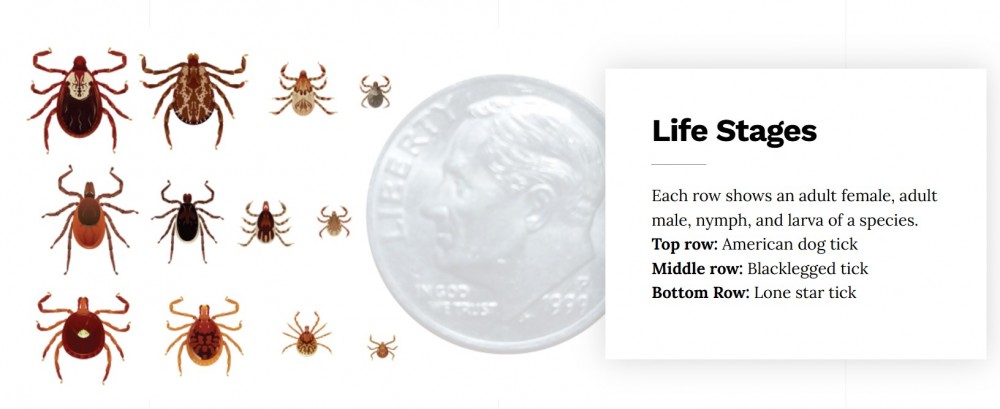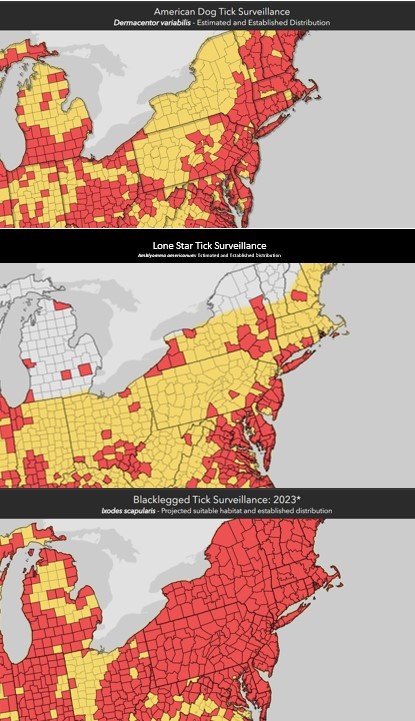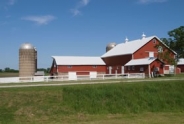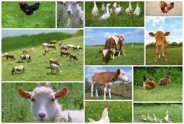Ticks Don't Die Over Winter? Well, that "Ticks" me Off!
Amy Barkley, Team Leader & Livestock Specialist
Southwest New York Dairy, Livestock and Field Crops Program
Ticks Don't Die Over Winter? Well, that "Ticks" me Off!
By Amy Barkley, Livestock Specialist SWNYDLFC
There is a long-held belief of many, including myself up until a few weeks ago, that the reason we've been seeing more ticks around is because our winters have been mild, since cold winters kill ticks. What we've been experiencing in WNY seems to support this claim! This November alone, my family ended up with multiple ticks on our cats and ourselves, which is unusual for us in WNY. However, with the past few years of mild winters, we weren't too surprised. I was wishing for a hard winter to kill them off, but apparently that's not going to work - here's why:
Ticks are hardy critters and go through multiple molts and feeds over the course of their lives. It's a relatively seasonal life cycle, where they feed on their hosts, drop off and develop for a season or two, and get their next blood meal to enter their next stage of life. It can take up to a year from the time ticks are hatched to the time they're ready to reproduce, and evidence shows that they'll survive months of sub-freezing temperatures. Observations of multiple populations also indicate that their lifecycle can be stretched out longer than a season if they encounter adverse conditions, like very cold, snowy weather.

Life stages of the three most common ticks in WNY. Chart from the Cornell IPM Program. Click to enlarge.
What cold winters do, however, is slow the spread of ticks into new ranges. In WNY, we commonly see the American dog tick, blacklegged tick, and lone star tick. The distribution maps below show the estimated distribution (shown in yellow) and established distribution (shown in red). The estimated distribution areas are classified as such because while ticks live there, an established population has not yet been found. The red areas indicate where an established population has been found. Cold winters limit those established populations from migrating to other regions as quickly as they would in warmer winters or winters that have extended warm seasons on either shoulder.

Distribution ranges of the the three common ticks in WNY, courtesy of the CDC. Click to enlarge.
Another thing to consider is that there are two new species of ticks, the Gulf Coast tick and the (Asian) longhorned tick, which are invasive and migrating up the East Coast. The longhorned tick is limited to the eastern side of the state and the Gulf Coast tick is just entering into that same region. As their populations become more established, we'll slowly see them moving northwest. If the winters continue to be mild, we'll see them move into our region faster.
Ticks are a cause of concern because of the human and livestock diseases they carry. Some common tickborne disease include lyme, alpha-gal allergy, tick paralysis, tularemia, anaplasmosis, borrelia, and others. Some ticks, like the longhorned tick, can build up in populations so large that they can cause anemia and death in livestock. We should do our best to limit exposure to these arachnids by limiting exposure to forest edges and keeping brush, weeds, and high grass mowed. Using pesticides for livestock and repellents for humans are successful ways of managing tick attraction and attachment. Checking your livestock regularly for ticks and collecting specimens to share with the NSY IPM lab can help researchers identify which ticks you have and determine if some of the more invasive species have settled in our region. Joellen Lampman is our contact for unusual tick ID and reporting of large infestations, and she can be reached by contacting her at (518) 441-1303 or jkz6@cornell.edu
Upcoming Events
Memoir Reading: Barn Gothic
December 4, 2025
Bath, NY
Barn Gothic is an elegy for family farmers and an intimate portrait of three generations laboring to be fathers and sons while their livelihood falls apart. Beautifully told with a farmer's restraint and a poet's grace, it is a story of personal loss amid corporate corruption and of finding a way forward when everything you know disappears.
NY Small Farms Summit 2025: Stronger Together
December 5, 2025
Alfred, NY
We hope you will join us on December 5th for the 2025 New York Small Farms Summit! This is an opportunity to meet other farmers and ag supporters, learn about research and education projects, and set priorities for future efforts to grow small farm success.
At the Allegany County site, we will focus on giving trees a chance and how trees build resiliency on small farms. Whether attracted to fruit, nuts, vegetables, fodder or shade, trees can be an integral part of a successful farming system. Join us as we explore the opportunities for resiliency that come from adding tree crops or managing wooded areas of your farm for agroforestry or silvopasture systems.
Crops, Cows & Critters - Southwest New York Dairy, Livestock & Field Crops Newsletter Sponsorship
December 19, 2025
Our two forms of publications feature research-based and timely information from our four specialists, listed to the right, along with local event notifications and Cornell University outreach. This information is provided to participants who range from dairy, livestock, and field crops producers to agricultural suppliers and consultants.
Weekly Email Update: Shared with 625+ households who have signed up with our program.
Monthly Paper Mailer: To reach our stakeholders and farmers who lack internet access, we send out a monthly mailer where your company's logo and contact information would be featured with a mailing list of 330+ households.
If you sponsor our weekly and monthly publications you reach approximately 955 households.
Visit our website to view our newsletters!
Announcements
No announcements at this time.





